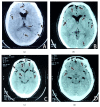Massive Cerebral Gas Embolism under Discectomy due to Hydrogen Peroxide Irrigation
- PMID: 25688310
- PMCID: PMC4320856
- DOI: 10.1155/2015/497340
Massive Cerebral Gas Embolism under Discectomy due to Hydrogen Peroxide Irrigation
Abstract
Massive cerebral and spinal gas embolism occurs rarely as a complication of discectomy. We report a 54-year-old female who had undergone a discectomy (L3/4 and L4/5) under epidural anesthesia in a local hospital developed multiple massive gas embolisms. At closure, surgeons irrigated the incision wound with hydrogen peroxide. Soon after the irrigation, the patient suddenly developed tachycardia, hypotension, and rapid oxygen desaturation. Subsequently, patient progressed into unconsciousness and right hemianopsia quadriplegia. Computed tomography (CT) scan showed multiple hypointensity spots around the brain due to cerebral gas embolism, which indicated the pneumoencephalos. The likely mechanism was the absorption of hydrogen peroxide into blood. When the amount of oxygen evolved exceeded its maximal blood solubility, venous embolization occurred. Though the patient was treated with supportive treatments and hyperbaric oxygen, she did not get full recovery and was left with severe long-term cerebral injury.
Figures
References
-
- Ciechanowicz R., Sein Anand J., Chodorowski Z., Kujawska-Danecka H. Acute intoxication with hydrogen peroxide with air emboli in central nervous system–a case report. Przegla̧d lekarski. 2007;64(4-5):339–340. - PubMed
LinkOut - more resources
Full Text Sources
Other Literature Sources


